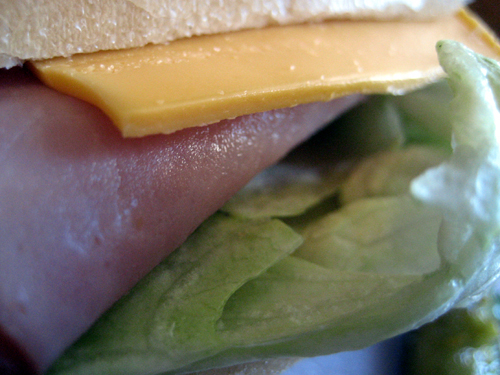Tue 31 Mar 2009
Gringowings: Hold the headcheese?
Posted by Super Burrito under Civic Center/Tenderloin, Polk Gulch, Tendernob
[4] Comments

It’s probably safe to say that headcheese is not the most popular luncheon meat in the US. Raised on a diet of TV commercials and fast food, there is little room for gelatinous foods. Maybe its because headcheese is too shiny for TV, or maybe we have just been exposed to fast food blandburgers for so long that our collective gullet is unappreciative of any textures that deviate too far from what is found on the dollar menu. Or maybe it is because headcheese just sounds gross.
Oddly discomforting in both name and description, headcheese is a pressed meat made from – you guessed it – pieces of skin and meat from the head of an animal. It has a rich history as a peasant food and there are many traditional variations across multiple cultures. As delicious as headcheese is, it isn’t for everybody, mostly due to its gelatinous nature. Since bánh mì is the new burrito, I took it upon myself to revisit Little Saigon and pick up a Euro sandwich. Don’t say I never did anything for you, Burritowingers.
Having a serious appreciation for the pairing of ham and cheese, I walked into Lee’s Sandwiches with my mind already made up. However, everything about ordering it felt wrong. So much so, that I couldn’t help ordering something else a little more appropriate. In addition to the ham and cheese sandwich, I also ordered a veggie bánh mì (bi chay), and a green coconut waffle (bánh kep). Having some Vietnamese names on the receipt made me feel a little bit better, and I knew in advance my meal was going to be diverse enough to satisfy.
The ham and cheese sandwich turned out to be pretty basic. For four dollars, the price was not bad, but there is simply no reason to order a Euro sandwich from Lee’s. Several pieces of generic ham and a couple of slices of American cheese were met with mayo and a sad bit of tomato. It was served with a pickle slice and a pepperoncini, and iceberg lettuce rounded out the vegetation. It was all held together inside the same delicious rice flour roll that is used for the Vietnamese sandwiches. Not bad, not good, just soulless. Which was of course no surprise, so no complaints here. It was, after all, still a perfectly adequate ham and cheese.
The vegetarian bánh mì was more of a success. The trio of meats present on my favorite special combo sandwich were replaced with a fried tofu rice vermicelli blend that was quite delicious. Combined with the obligatory carrot, cilantro and daikon mix, the veggie sandwich might make a good option for lighter fare, but at the same price as a special combo, I see no reason not to get that instead.

For dessert I had a bánh kep, which is a green coconut milk waffle. Despite its color, the most prominent ingredient is the coconut milk. Green due to the use of pandan or cilantro leaves, the bánh kep is sweet, with a slight herbal taste. No syrup is needed, as the waffle is good just the way it is served. It worked as a compliment to both the veggie bánh mì, and the boring ham and cheese sandwich.

I don’t regret getting a ham and cheese sandwich at a Vietnamese bánh mì shop, but it’s not something I plan on doing again. Perhaps the headcheese, pâté and pork special combo might be considered an adventurous sandwich to some, but I cannot help but think it is a special sandwich that has been more discovered than created. Much like ham and cheese seem to be natural compliments to each other, gelatinous headcheese, smooth pâté and sturdy pork slices will always have a place all of their own in my particular list of foods that belong together.
What is most important about bánh mì being the new burrito is that there are choices. One could go adventurous with pressed pork, or play it safe with a ham and cheese sandwich. Vegetarian options also exist and are quite delicious. If I were one to avoid headcheese or meat all together, the bi chay would be a more than suitable option. It was the hunt for a vegetarian burrito that led me into accepting the bánh mì as a particular antidote for a specific craving, but with so many options, the bánh mì is capable of satisfying any hunger.

